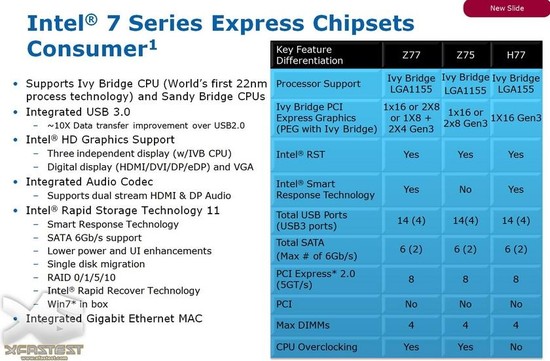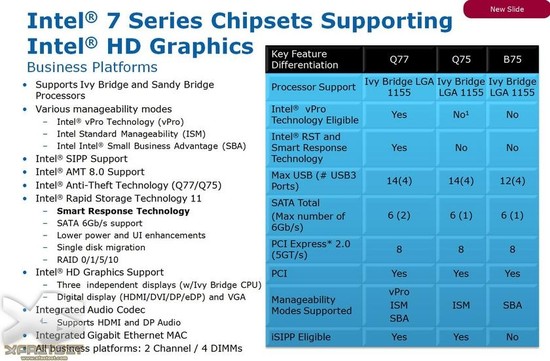During the first half of 2012 Intel is expected to release its first processors spawning of the 22nm node and these have been code-named Ivy Bridge, the successor to Sandy Bridge. Ivy Bridge will be compatible with LGA 1155 motherboards with chipsets of the 6 series, but it will release a new 7 series with USB 3.0 and PCI-Express 3.0, which comes integrated with Ivy Bridge.
Ivy Bridge is still far away since the launch is slated for H1 2012 and it will then become the first microprocessor at 22nm. The processor will bring lower power consumption, together with higher clock frequencies, but also the chipsets will get a special treatment.
The three chipsets for retail are Z77, Z75 and H77, while Q77, Q75 and B77 targets the office, which makes us want to focus on the first three. The tiny details that most usually don’t care for are what really matters with these three.


Z77, Z75 and H77 will all support D-Sub, DVI, HDMI and DisplayPort, and be able to power up to three separate monitors. We also see four native USB 3.0 ports and PCI-Express 3.0 (only Ivy Bridge). All chipsets will bring what Intel calls Rapid Storage Technology, which includes everything from SATA 6 GB/s to RAID, although Z75 lacks Smart Response Technology, also known as SSD-caching, which will debut with Z68 next month.
Other news include eight PCI-Express 2.0 lanes for the chipset, which results in a nice boost of bandwidth if the manufacturers want to install additional SATA 6 GB/s ports, USB 3.0 or something else. AMD’s coming chipset will only sport four PCI-Express 2.0 lanes so the expansion possibilities are much greater with Intel’s coming 7 series and could potentially offer twice the internal bandwidth as AMD’s alternatives.
Ivy Bridge looks interesting even though it is just a shrink of Sandy Bridge, but it does bring PCI-Express 3.0 and much improved chipsets. It’s a shame we won’t see USB 3.0 any earlier from Intel even though the majority of motherboards already support it through discrete controllers.
Source: XFastest















